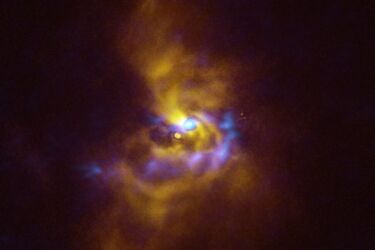How giant planets are born: Scientists discover dust clouds around a young star for the first time

Observations of the dust cloud surrounding a newborn star called V960 Mon have revealed clumps of material that could be the early stages of the birth of gas giant planets such as Jupiter. The astronomers used the Very Large Telescope and the Atacama Large Millimeter/submillimeter Array to make the discovery.
This discovery may shed light on the connection between the formation of stars and planets, which is one of the key questions in astronomy. The results of the study were published in The Astrophysical Journal Letters.
Read also: Hubble telescope detects wandering black holes (photo)
According to models, gas giants have two ways of formation. The first is "bottom-up" when clumps of material gradually stick together and form planets similar to Earth and Mars. The second way is "top-down" when a denser clot in a cloud collapses under the influence of gravity and forms a baby planet. Both scenarios are plausible, so astronomers have been actively looking for signs of such early stages of formation in the material around young stars.
V960 Mon is a young star in the constellation of the Unicorn, located about 7120 light-years from Earth. It is a prime example of a young star that is still growing. During its observations, a bright outburst was seen, which is an accretion event when material from a cloud falls onto a star.
Astronomers discovered strange structures that indicate the process of fragmentation of the disk of material around the star using the VLT SPHERE optical infrared instrument and the ALMA telescope. The disk is fragmented into clumps that can coagulate into planet seeds.
This discovery is very exciting for the scientific community as it is the first find of clumps around a young star that could be potential germs of gas giant planets. Data from such observations will help us better understand the formation of these huge worlds, which have been shrouded in dust and mystery until now.
Future work using other telescopes will also be aimed at studying similar outbursts of young stars to find new evidence of disk fragmentation and gravitational instability in the formation of planets.
As a reminder, scientists have answered which asteroids can destroy the Earth and when it might happen.
If you want to get the latest news about the war and events in Ukraine, subscribe to our Telegram channel!
